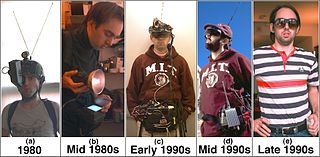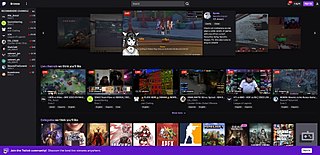A webcast is a media presentation distributed over the Internet using streaming media technology to distribute a single content source to many simultaneous listeners/viewers. A webcast may either be distributed live or on demand. Essentially, webcasting is "broadcasting" over the Internet.
Streaming television is the digital distribution of television content, such as television shows and films, as streaming media delivered over the Internet. Streaming television stands in contrast to dedicated terrestrial television delivered by over-the-air aerial systems, cable television, and/or satellite television systems.

BBC iPlayer is a video on demand service from the BBC. The service is available on a wide range of devices, including mobile phones and tablets, personal computers and smart televisions. iPlayer services delivered to UK-based viewers feature no commercial advertising. The terms BBC iPlayer, iPlayer, and BBC Media Player refer to various methods of viewing or listening to the same content. To use the service, a valid TV Licence is required.

YouTube is an American online video sharing and social media platform owned by Google. Accessible worldwide, it was launched on February 14, 2005, by Steve Chen, Chad Hurley, and Jawed Karim, three former employees of PayPal. Headquartered in San Bruno, California, United States, it is the second most visited website in the world, after Google Search. YouTube has more than 2.5 billion monthly users, who collectively watch more than one billion hours of videos every day. As of May 2019, videos were being uploaded to the platform at a rate of more than 500 hours of content per minute, and as of 2023, there were approximately 14 billion videos in total.
Internet video is digital video that is distributed over the internet. Internet video exists in several formats, the most notable being MPEG-4i AVC, AVCHD, FLV, and MP4.

Justin Kan is an American internet entrepreneur and investor. He is the co-founder of live video platforms Justin.tv and Twitch, as well as the mobile social video application Socialcam. He is also the cofounder and former CEO of law-tech company Atrium. In 2024, Kan announced that he had founded Stash, a payment and e-commerce platform for video game developers.

Justine Ezarik is an American YouTuber. She is best known as iJustine, with over one billion views on her YouTube channel. She gained attention as a lifecaster who communicated directly with her millions of viewers on her Justin.tv channel, ijustine.tv. She acquired notability in roles variously described as a "lifecasting star", a "new media star", or one of the Internet's most popular lifecasters. She posts videos on her main channel iJustine.
BlogTalkRadio is a web-based platform that allows podcasters and radio sites and talk show hosts to create live and on-demand talk format content for distribution on the web and podcast distribution channels. Its claim to fame is a web-based 'studio' that allows its content creators to host multi-participant broadcasts using a computer and a phone.

Lifestreaming is an act of documenting and sharing aspects of one's daily experiences online, via a lifestream website that publishes things of a person's choosing.

A lifelog is a personal record of one's daily life in a varying amount of detail, for a variety of purposes. The record contains a comprehensive dataset of a human's activities. The data could be used to increase knowledge about how people live their lives. In recent years, some lifelog data has been automatically captured by wearable technology or mobile devices. People who keep lifelogs about themselves are known as lifeloggers.
FilmOn is an Internet-based television provider owned by FilmOn.TV Networks Inc. Alki David had founded FilmOn.TV Networks in 2006. The company was involved in a prolonged legal case concerning streaming rights with CBS, Fox, and NBC between 2013 and 2017, with FilmOn ultimately settling.

Livestreaming, live-streaming, or live streaming is the streaming of video or audio in real time or near real time. While often referred to simply as streaming, the real time nature of livestreaming differentiates it from other forms of streamed media, such as video-on-demand, vlogs, and YouTube videos.
Jennifer Kaye Ringley is an Internet personality and former lifecaster. She is widely regarded as the first camgirl. She is known for creating the popular website JenniCam. Previously, live webcams transmitted static shots from cameras aimed through windows or at coffee pots. Ringley's innovation was simply to allow others to view her daily activities. She was the first web-based "lifecaster". She retired from lifecasting at the end of 2003.
AfreecaTV is a P2P technology-based video streaming service. It is now owned and operated by AfreecaTV Co., Ltd. in South Korea after Nowcom's AfreecaTV Co., Ltd and ZettaMedia split in 2011. As of July 2019 AfreecaTV was listed 4th in the "Asia's 200 Best Under A Billion" list by Forbes.

Twitch is an American video live-streaming service that focuses on video game live streaming, including broadcasts of esports competitions, in addition to offering music broadcasts, creative content, and "in real life" streams. Twitch is operated by Twitch Interactive, a subsidiary of Amazon.com, Inc. It was introduced in June 2011 as a spin-off of the general-interest streaming platform Justin.tv. Content on the site can be viewed either live or via video on demand. The games shown on Twitch's current homepage are listed according to audience preference and include genres such as real-time strategy games (RTS), fighting games, racing games, and first-person shooters.

Emmett Shear is an American Internet entrepreneur and investor. He is the co-founder of live video platform Justin.tv. He served as the chief executive officer of Twitch when it was spun off from Justin.tv until March 2023. In 2011, Shear was appointed as a part-time partner at venture capital firm Y Combinator. In November 2023, he briefly served as interim CEO of OpenAI.

Aereo was a technology company based in New York City that allowed subscribers to view live and time-shifted streams of over-the-air television on Internet-connected devices. The service opened to customers in March 2012, and was backed by Barry Diller's IAC.
The live streaming of video games is an activity where people broadcast themselves playing games to a live audience online. The practice became popular in the mid-2010s on the US-based site Twitch, before growing to YouTube, Facebook, China-based sites Huya Live, DouYu, and Bilibili, and other services. By 2014, Twitch streams had more traffic than HBO's online streaming service, HBO Go. Professional streamers often combine high-level play and entertaining commentary, and earn income from sponsors, subscriptions, ad revenue, and donations.

An online streamer or live streamer is a type of social media influencer who broadcasts themselves online through a live stream to an audience.

BlogTV was a live-streaming video blog service reintroduced by MadCow Disease Media LLC, in January 2016. BlogTV was first established in Ramat Gan, Israel in January 2004 by founders Ilan Ben-Dov, Dan Chen, Guy Eliav, Nir Ofir, and Oren Levy as a webcasting company. The service operated under the Tapuz brand. BlogTV's goals were to provide a means for anyone with Internet access to express their talents and ideas to the world. In 2006 BlogTV launched its Canadian activity under the name BlogTV.ca. BlogTV.com was officially launched in June 2007 in the US and the rest of the world. Users could create live video shows, interact with their audiences or invite co-hosts to join their show over the internet or by using WAP. The broadcasters were able to broadcast to their audience with a webcam. The platform also included a chat system. The site had a promotional partnership with ICQ, an IM platform. YouNow acquired BlogTV.com on March 13, 2013.













